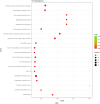Comparative genomic and transcriptome analysis of Bacillus velezensis CL-4 fermented corn germ meal
- PMID: 36683079
- PMCID: PMC9868226
- DOI: 10.1186/s13568-023-01510-5
Comparative genomic and transcriptome analysis of Bacillus velezensis CL-4 fermented corn germ meal
Abstract
Bacillus, an excellent organic-degrading agent, can degrade lignocellulose. Notably, some B. velezensis strains encode lignocellulases. However, their ability to degrade lignocellulose in fermented feed is not much appreciated. This study performed a comparative genomic analysis of twenty-three B. velezensis strains to find common carbohydrate-active enzymes (CAZymes) encoding genes and evaluated their potential to degrade lignocellulose. The comparative genomic and CAZyme database-based analyses identified several potential CAZymes genes that degrade cellulose (GH1, GH4, GH5, GH13, GH16, GH32, PL1, and PL9), hemicellulose (GH11, GH26, GH43, GH51, and CE3) and lignin (AA4, AA6, AA7, and AA10). Furthermore, Illumina RNA-seq transcriptome analysis revealed the expression of more than 1794 genes in B. velezensis CL-4 fermented corn germ meal at 48 h (FCGM 48 h). Gene ontology analysis of expressed genes revealed their enrichment in hydrolase activity (breaking the glycosyl bonds during carbohydrate metabolism), indicating the upregulation of CAZymes. In total, 58 differentially upregulated CAZymes-encoding genes were identified in FCGM 48 h compared to FCGM 0 h. The upregulated CAZymes-encoding genes were related to cellulose (6-phospho-β-galactosidase and 6-phospho-α-glucosidase), starch (α-glucosidase and α-amylase), pectin (pectin lyase), and hemicellulose (arabinan endo-1,5-α-L-arabinosidase, xylan 1,4-beta-xylosidase, α-N-arabinofuranosidase, and acetyl xylan esterase). Importantly, arabinoxylan degradation mainly occurred in FCGM 48 h, followed by partial degradation of cellulose, pectin, and starch. This study can support the development of enzymatic cocktails for the solid-state fermented feed (SFF).
Keywords: B. velezensis CL-4; Comparative genomics; Corn germ meal; Lignocellulose-degrading enzymes; Transcriptome.
© 2023. The Author(s).
Conflict of interest statement
The authors declare that they have no confict of interest.
Figures



References
LinkOut - more resources
Full Text Sources
Miscellaneous

